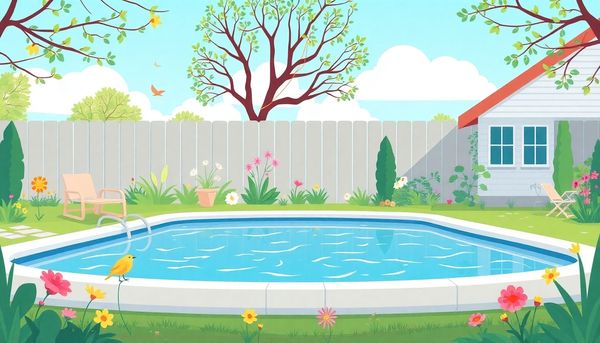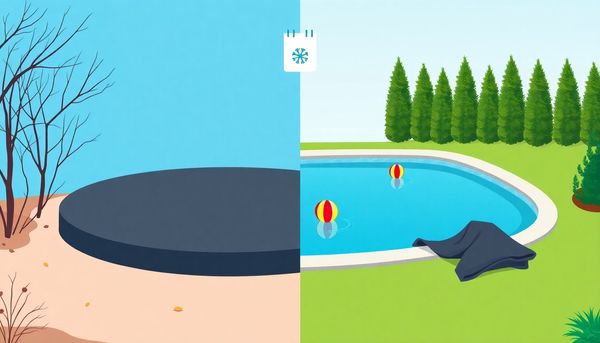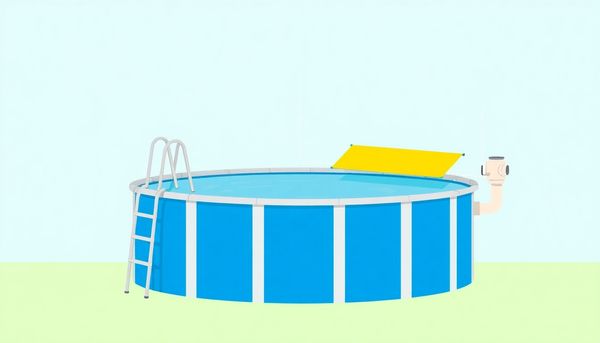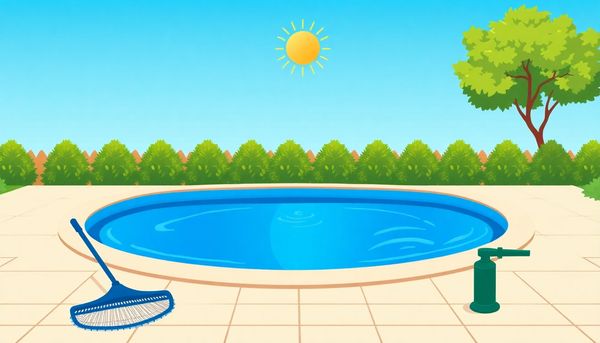Spring Pool Opening: Easy Steps for a Sparkling Start
November 21th, 2024
November 21th, 2024
The first warm breeze of spring carries with it a promise: the return of poolside days and sun-kissed afternoons. For those fortunate enough to own an above-ground pool, this season marks the beginning of a cherished ritual. As the world awakens from winter's slumber, so too must your pool, yearning to be freed from its protective coverings, ready to serve as the centerpiece for fun and relaxation.
It wasn't long ago that my own pool sat dormant, a hibernating giant beneath layers of cover and debris. Opening it felt like unlocking a treasure chest. With each step, from peeling back the cover to the first splash of crystal-clear water, there's a sense of satisfaction that grows. Each movement is purposeful, from reconnecting the pump to balancing the chemicals, all working together to transform a murky expanse into a sparkling oasis.
Every pool owner knows the feeling of that first dive into freshly prepared water, invigorating and refreshing. The journey of preparing the pool is akin to a gardener cultivating their plot, each action deliberate and rewarding. Whether you're a seasoned pool veteran or undertaking this task for the first time, understanding the process ensures a smooth transition from the cover to the cool embrace of water. It’s more than just a checklist; it’s the start of a season filled with laughter and memories. With this guide, opening your pool becomes a breeze, paving the way for endless summer days.

The time has come to unveil your pool as the winter chill fades away, but a bit of preparation is necessary to ensure a smooth transition into swim season. Start by assessing the state of your winter pool cover. It has weathered snowstorms and fallen leaves, bearing the brunt of the elements to keep your pool pristine underneath. Removing this cover requires a little finesse and teamwork—an ideal moment to call upon that trusty friend.
First, tackle any excess water accumulated on the cover. A handy submersible pool cover pump, or even a regular sump pump, will efficiently drain away the unwanted water. Next, gently use a soft broom or skimmer net to sweep away leaves and debris, careful not to snag the cover with sharp tools. This step not only preserves the cover's integrity but also minimizes the mess that might otherwise plummet into your pool.
Once the cover is free of detritus, carefully peel it back with your friend's help. The trick here is to lift, not drag, keeping any remaining debris from taking a plunge. If you used an air pillow, deflate and remove it alongside the cover; it’s done its job by absorbing winter’s icy pressure.
Lay the cover flat on a clean surface—perhaps your lawn or driveway—and give it a thorough wash with cover cleaner or car wash soap. Use a scrub brush or soft broom, but take care to be gentle. Proper drying and storage in a sealed container will prolong its life, sparing you the expense of frequent replacements. Now, with the cover safely stored away and your pool plugs removed, you're one step closer to diving into a summer of fun.
When winter bids farewell and the allure of sunny days draws you to your above ground pool, the first task at hand is tackling the debris on its cover. A season’s worth of leaves, twigs, and accumulated water may seem daunting, but with the right approach, it’s entirely manageable.
Begin by assessing the situation. If water has pooled on top, a submersible pool cover pump or a simple sump pump will be your best allies. These tools efficiently remove excess water, sparing you the hassle of manually draining it. Be patient; let the pump work its magic while you gather your other cleaning supplies.
With the water gone, attention shifts to the dry matter—leaves and other debris. A soft bristled broom or a skimmer net will serve you well here. Gently sweep across the cover to avoid tearing it, as a light touch prevents damage while efficiently removing unwanted mess. Remember, the more debris you clear now, the less will ultimately tumble into your pool when you unveil it.
As you work, enlist the help of a friend. It's always more fun and effective with an extra set of hands. Once most of the debris is off, carefully remove the cover without dragging it, ensuring nothing remaining falls into the pool. This foresight saves you considerable effort later when balancing water chemistry and prepping for that first splash of the season.
After months of shielding your pool from the elements, it's time to give that trusty cover a little TLC. It might seem like a cumbersome task, but treating it right now will pay dividends in longevity, saving you from prematurely shelling out for a replacement. Start by selecting a spacious, clean area — your driveway or a patch of lawn can do the trick. Roll out the cover, checking for any sharp objects that could cause tears.
Next, grab a hose, a gentle cover cleaner or car wash soap, and a soft broom or scrub brush. Begin by spraying down the cover with water to loosen any stubborn dirt. With the scrub brush in hand, gently work in the cleaner. Think of it like washing a car, but instead of polishing up the family sedan, you're ensuring a season of fun in the sun. Once all grime is banished, rinse thoroughly.
Drying is crucial to prevent mold and mildew. Allow the cover to bask in the sun until it’s completely dry. Only then should it be folded and stored in a large, sealed plastic container. This fortress against critters will protect your investment from becoming a rodent’s chew toy.
By taking these extra steps, you set your pool cover up for success — ready to serve again when the chill returns. And with that, you can turn your attention to the next steps of prepping your pool for a season of splashy fun.
The season of swimsuits and sunblock is nearly upon us, and with it comes the delightful task of reconnecting your above ground pool equipment. This might sound like assembling a jigsaw puzzle, but with a little guidance, it’s a cinch. First, reacquaint yourself with the pool’s heart—the pump and filter system. All those plugs you carefully stored away last season? It’s time to replace them on drains and pressure gauges.
Next, ensure the system’s hoses are securely attached. A loose hose can become a surprise sprinkler, and while that may entertain the neighborhood kids, it won’t do your pool any favors. If your setup includes a multiport valve, set it to the filter position.
Once everything is snug and secure, it’s showtime. Power up the system and keep a watchful eye for any leaks or odd noises. A trick learned from a seasoned pool enthusiast is to gently tap the pump to coax any trapped air out. If the pump sounds like it’s struggling, a little priming might be in order. Simply add water to the pump to give it a boost.
When all components are humming along nicely, backwash the filter to clear out accumulated debris. If your filter uses diatomaceous earth, don’t forget to replenish it post-backwash. With everything running smoothly, your pool is one step closer to hosting its first splash of the season.

Once the pool cover is secured for the season, attention turns to the gear that makes pool life a breeze. Those nets, brushes, and hoses you relied on last year need a little TLC before they can tackle another season of splashing and sunbathing. Start by gathering all your pool equipment and checking each item for wear and tear. A cracked skimmer net or a brittle hose can spell trouble down the line, so replace any gear that looks past its prime.
Cleaning your equipment is the next crucial step. For nets and brushes, a good rinse with a garden hose can remove any leftover grime. If you’re feeling thorough, a mild detergent and warm water will do wonders for that stubborn dirt. Don’t forget about your hoses—give them a good flush to clear out any lingering debris. While you’re at it, inspect for leaks or weak spots that might transform into pesky problems mid-season.
Once everything sparkles like new, proper storage is key. Find a dry, shaded spot—perhaps a garage or garden shed—where your gear can rest without being exposed to the elements. Consider investing in storage bins to keep everything organized and protected from curious critters. With your pool gear cleaned and stored, you’re one step closer to a seamless pool opening, ensuring that when the temperatures rise, your poolside essentials are ready to serve.
Winter has finally loosened its grip, and it's time to unveil your above ground pool's hidden treasure—the water beneath the cover. The first mission: tackling the pool cover, which has served faithfully through the cold months. Contrary to the temptation of simply yanking it off, there's a more meticulous approach to ensure a smooth start to your swimming season.
Begin with a trusty pool cover pump. This little gadget will efficiently siphon off any accumulated water. If you lack a cover pump, a regular sump pump will suffice, though it might require a touch more patience. Meanwhile, a soft broom or skimmer net can come to the rescue for leaf and debris removal. Handle these tasks with care to avoid any damage to the cover.
Once debris-free, join forces with a friend to lift the cover without dragging it. This helps avoid any residual dirt slipping into the water. If you used an air pillow to protect your pool walls from winter’s icy expansion, carefully remove and deflate it too.
Next, spread your cover across a flat, clean surface like your lawn or driveway, ensuring no sharp objects hide beneath. With a mixture of water, cover cleaner, and a gentle brush, scrub away the grime. Thorough cleaning prolongs the cover's life, saving you the expense of frequent replacements. Allow it to dry completely before storing it in a sealed container, safeguarding it from critters and moisture damage. With the cover securely tucked away, you're one step closer to the refreshing embrace of summer waters.
Before the first splash of the season, your pool equipment deserves a little tender care and attention. Think of it as reacquainting yourself with an old friend you haven't seen in months. Start by gathering all necessary tools and accessories such as hoses, filters, skimmer nets, and any other gear that spent the winter in storage. Each item has its own tale to tell, woven from countless sunny days in past seasons.
Inspect each piece for signs of wear and tear. A cracked hose or a rusty ladder rung might seem minor now, but they could lead to bigger headaches once the pool is operational. Consider replacing anything that looks suspect. Remember, it's easier to swap a part now than to deal with an emergency later on. Personally, I once ignored a tiny crack in a pool hose, and let me tell you, it turned into a mini-geyser once the pump started.
Once everything checks out, give your equipment a good wash. A simple soap and water solution works wonders, removing dust and grime accumulated during storage. Thoroughly drying each piece before reassembly prevents mildew and ensures a fresh start.
Finally, store your equipment conveniently close to the poolside. This keeps the essentials at arm's reach, so you spend less time scrambling for tools and more time enjoying your pool. With everything prepped and primed, you're now one step closer to a flawless opening.
Testing and balancing your pool's water chemistry can be likened to fine-tuning an orchestra. Each element needs to hit the right note to ensure a harmonious swimming experience. The first step is to reach for your trusty test strips or a liquid test kit. These tools will help you gauge the chemical composition of your pool, including pH, alkalinity, and chlorine levels. Each parameter plays a crucial role: too much acidity can irritate skin, while improper chlorine levels might leave your pool resembling a pond more than a refreshing oasis.
After getting your initial readings, it’s time to adjust. If your pH isn’t within the ideal range of 7.4 to 7.6, consider adding pH increaser or decreaser. For alkalinity that’s off the mark, baking soda can be your best friend. Remember the science experiments from school? That’s the same enthusiasm you'll need here—except now, the payoff is a summer of clear, inviting waters.
Once everything is balanced, it’s time for the big guns: shocking the pool. This involves adding a concentrated dose of chlorine to eliminate lingering bacteria and algae. Opt for a double shock, particularly if your pool has been dormant for an extended period. And here's a tip: perform this step after the sun goes down to prevent UV rays from diminishing the shock’s efficacy. Lastly, let your pump run its course overnight to circulate the chemicals evenly. With balanced chemistry, your pool isn’t just water—it’s a symphony of sparkling refreshment.

Reinstalling pool equipment can feel like a reunion of old friends, each piece vital to ensuring a smooth summer season. After a long winter rest, your pool's hardware needs to be revived. Start by reinstating all plugs, drains, and pressure gauges to your pool's filter system, pump, and other essential equipment. Each component plays a crucial role, akin to an orchestra coming together to create a harmonious tune.
Next, connect the system’s hoses to the appropriate equipment. This step demands attention, as a loose connection can lead to unwanted leaks. Once everything is securely attached, check that the multiport valve is set to the filter position, ensuring water flows correctly through the system. It's like aligning the stars, only instead of celestial bodies, you’re dealing with pool parts.
Now comes the moment of truth: power up your system. Listen for the comforting hum of the pump and keep an eye out for any drips. If it’s not flowing as it should, priming the pool pump might be necessary. This involves shutting off the system, removing the pump lid, and adding water from a garden hose—simple steps that can make a world of difference.
Lastly, consider the specifics of your filter type. If using a sand or diatomaceous earth filter, backwashing is essential. Always adhere to your manufacturer’s guidelines to avoid mishaps. With everything in place, your pool equipment should be ready to keep your waters clear and inviting all summer long, providing the perfect backdrop for your sun-soaked memories.
As spring breezes begin to thaw the last traces of winter, the pool in your backyard beckons once again. But before cannonballs and sunbathing can commence, there’s a crucial step: dealing with the remnants of winter. Your pool cover, which has dutifully protected your oasis from the elements, is likely heavy with a mix of leaves, twigs, and water. Tackling this task requires a bit of care and the right tools.
Start by enlisting a trusty companion—a pool cover pump. This handy device effortlessly siphons away any accumulated water. If a pool cover pump isn’t part of your toolkit, a regular sump pump will do just fine. As you watch the water being whisked away, grab a skimmer net or a gentle broom and begin clearing away leaves and debris. Remember, a light touch is key; a vigorous sweep might make holes in the cover, sending the mess into your pool.
Once the cover is free of debris, enlist the help of that friend who owes you a favor to carefully lift it off. Take it slow to avoid any leftover gunk from plopping into the clear waters beneath. With the cover off, stretch it out on a clean, flat surface. Give it a thorough rinse using a mild detergent and a soft brush, and allow it to dry completely. Tucking it away in a secure container ensures it’s safe until next winter, away from prying critters.
Now, with the pool basking in the open air, you’re one step closer to diving into those sunlit days.
When the chill of winter finally gives way to the warmer embrace of spring, it's time to awaken your pool's filter system from its hibernation. This critical step ensures that your oasis remains clean and inviting throughout the swimming season. Start by returning all the winterized plugs to their rightful places in the pool filter system, pump, and other related equipment. It's a bit like fitting puzzle pieces back together, ensuring everything is snug and secure.
Hoses, often forgotten in a shed corner, need to be reattached to their respective valves and equipment. Make sure each connection is tight to prevent any unexpected leaks. If your system features a multiport valve, it should be set to the 'filter' position to get things running smoothly. Once everything is in place, it’s time to power it up. Listen for the gentle hum of the system starting and inspect for any drips or leaks—tell-tale signs that something might need tightening.
Sometimes, the pump may need a little encouragement to start. Priming can be achieved by adding water directly into the pump housing. Simply remove the pump lid, pour in water, and replace the lid securely before restarting the system. Finally, backwash your filter—whether it uses sand or diatomaceous earth (DE)—to clear out any debris accumulated over winter. Follow the manufacturer’s instructions closely for best results. With the pool-filter system reconnected, your pool is one step closer to being ready for summer fun.
Grabbing your test kit and getting hands-on with your pool water is where the magic really begins. After all the winter lethargy, your pool needs a chemistry check-up as much as it needs cleaning. Start by dipping a test strip or using a liquid test kit to measure the water's pH, alkalinity, and chlorine levels. These readings will provide a snapshot of your pool's current state. On a sunny afternoon, my friend Kevin and I tackled this task. We discovered our pH levels were way off, leading to a quick trip to the pool supply store for adjustments.
pH levels should hover between 7.2 and 7.6 for a perfect swim, with alkalinity maintaining a balance between 80 to 120 parts per million. If your readings are outside these ranges, don’t fret. Adjust with pH increaser or decreaser, and use baking soda to raise alkalinity or muriatic acid to lower it. Kevin was skeptical at first, but a little adjustment here and there, and we had our water looking like it belonged in a glossy magazine.
Once balanced, it’s time to shock your pool. This step is crucial to clear away any bacteria or algae that might have snuck in during the off-season. Remember, shocking should be done at dusk to ensure the chemicals aren't quickly dissipated by sunlight. It’s this attention to detail that transforms murky, unused water into a welcoming oasis. With everything in place, you’re almost at the finish line. Let the system churn away, and soon enough, you'll have a refreshing pool ready for summer splashes.

Balancing pool chemistry might sound like the realm of a scientist, but it’s more akin to baking the perfect cake—a little of this, a bit of that, and voila, a masterpiece ready to enjoy. As you stand beside your above ground pool, newly unveiled from its winter slumber, think of yourself as the head chef preparing for a grand opening.
Begin with a reliable test kit; it’s your recipe book. Dip those strips or use the liquid kit to measure essential levels: pH, alkalinity, calcium hardness, and chlorine. Each number tells a story about what your pool needs next. For instance, if the pH level is off, your swimmers might end up with itchy skin, and if it’s too high, the water can turn cloudy—an unappealing backdrop for any sunny day.
Adjusting the pH to a comfortable 7.4 to 7.6 ensures the water feels gentle against your skin. Alkalinity acts as the buffer, keeping pH stable, so aim for a range of 80 to 120 parts per million (ppm). Calcium hardness, often overlooked, should nestle between 200 to 400 ppm to prevent etching and scaling. Lastly, chlorine does the heavy lifting, sanitizing the water to keep it crystal clear and safe—1 to 3 ppm is the sweet spot.
Picture this balance as your safety net, ensuring a summer of worry-free swimming. Once you’ve nailed these levels, you’re not just ready to open your pool; you’re set to dive into a season of refreshing dips and sun-soaked memories.
Unveiling your above ground pool from its winter slumber feels like unwrapping a long-anticipated gift. The first order of business? Clearing away the debris that’s been patiently waiting atop your pool cover. It's akin to sweeping away the cobwebs from a long-closed room; a bit of effort now makes for a grand reveal later.
Start with a reliable pool cover pump to remove any accumulated rain or melted snow. This handy device detects water presence and does the heavy lifting, ensuring your cover isn't weighed down by excessive moisture. If you find yourself without one, a sump pump can fill in admirably. With the water gone, it’s time to tackle those pesky leaves and twigs. A soft broom or skimmer net is your best partner here—avoid any sharp tools that might tear the cover.
It’s tempting to rush this step, but gently removing debris now saves you from dealing with a foamy, leaf-filled pool later. Once the surface is clear, enlist the help of a friend to carefully peel back the cover. Teamwork is key here; a smooth, synchronized lift prevents any last bits of debris from plummeting into your soon-to-be pristine pool.
Lay the cover out on a flat, safe surface—your driveway or lawn works well—and give it a thorough clean. Use a soft brush and a mild soap solution to scrub away any dirt or mildew. Let it dry completely before storing it safely, ensuring no moisture remains that could lead to mold during storage. A little foresight now ensures your pool cover remains sturdy and reliable year after year.
Emerging from the long winter months, your pool equipment eagerly awaits its moment to shine—like an orchestra patiently waiting for the conductor's cue. Each piece, from the pump to the filter, plays a vital role in ensuring your pool is ready for a summer of splashes and laughter. Begin with the basics: locate the plugs for your drains and pressure gauges. These little components may have hibernated through the cold, but now they need to be snugly replaced into your pool filter system and pump.
Reattaching your system’s hoses is the next step, a task that requires a bit of diligence. Connections should be firm to prevent any unwanted leaks once the system roars back to life. Pay attention to the multiport valve if your setup includes one; it should be set to the filter position before proceeding.
With everything in its place, it’s time to give life back to your pool system. Starting up the pump can feel like reviving an old friend—listen attentively for the hum of machinery and watch for any signs of moisture sneaking from seams that should be dry. If it seems not quite right, priming the pool pump could be your solution. This involves introducing water directly into the pump to jumpstart its circulation ability.
Finally, if your filter system uses sand or diatomaceous earth, backwashing will clear out the remnants of a dormant season. Each filter type has its nuances, so consulting the manufacturer’s instructions is always wise. Before long, your pool will be on its way to that crystal-clear shine, ready to host all the summer fun you’ve been dreaming about.
Water chemistry might sound like a term best left to chemists in white lab coats, but when it comes to your pool, it's essential to get right. Over the winter, your pool's water has likely turned into a science experiment gone wrong, with imbalances that can irritate skin or even damage your pool's surfaces. This is where balancing water chemistry steps in, transforming that murky mess into a crystal-clear oasis.
Start by testing the water with either test strips or a liquid test kit. You're checking for key players like pH, alkalinity, and chlorine levels. Each element needs to dance in harmony. For instance, pH should hover between 7.4 and 7.6—not too acidic, not too basic. Alkalinity acts as your water's buffer, keeping pH swings at bay, and should measure between 80 and 120 ppm. Meanwhile, chlorine levels should sit between 1 and 3 ppm to keep bacteria at bay.
If you're not keen on playing chemist, most local pool supply stores offer testing services. Take a sample of your water in a clean bottle, and let them provide a detailed analysis. They might even suggest specific products tailored to your results.
Once your water is balanced, don’t forget to shock your pool. This process oxidizes any remaining impurities, ensuring your pool’s fresh start is as clean as possible. Keeping your pool chemistry in check is like having a reliable friend; they prevent surprises and make every swim enjoyable.

Every spring, as the cover comes off your above-ground pool, the anticipation of crystal-clear water beckons. Yet, before you take that plunge, there's a crucial step that can't be overlooked: shocking and filtering your pool water. This process is more than just a routine task; it's the key to transforming that stagnant winter water into a sparkling oasis.
To start, you'll need to shock your pool, which is essentially a concentrated dose of chlorine designed to obliterate any bacteria or algae that have taken up residence during the colder months. Grab your pool shock product, and remember the right dosage is critical—use 2 pounds of shock for every 10,000 gallons of water. Timing is also crucial. Shocking at dusk prevents the sun from evaporating the chlorine before it has a chance to work its magic.
Once the shock has been administered, let your pool's pump and filter system do the heavy lifting. Running the system continuously for at least 24 hours ensures that the shock is evenly distributed and the water is thoroughly circulated. During this time, keep an eye on the pool's surface and vacuum away any debris that may appear.
After a full day of filtration, it's time to test the water. Using a reliable test kit, check the levels of chlorine, pH, and alkalinity. Adjust them as needed to achieve the perfect balance. With everything in order, the water will be inviting, ready to welcome you to a season of refreshing swims.
Taking the plunge into pool season starts with the crucial task of removing your pool cover safely. As the weather warms up, your pool cover may look like a canvas of collected muck, but with the right approach, you can tackle this job without turning your pool into a debris-filled pond. Begin by employing a trusty pool cover pump to siphon off any collected water. This handy tool prevents the inadvertent dousing of your clear pool water with murky leftovers from the cover. No pump on hand? A regular sump pump can fill in quite adequately.
Next comes the gentle art of debris removal. Armed with a soft broom or skimmer net, sweep away leaves and twigs. It’s a bit like coaxing dust off an old book—treat your cover with care to avoid any pesky tears or stretches. With your friend lending a hand, lift the cover slowly and methodically, being mindful not to let any lingering debris rejoin your pool.
Once the cover’s off, find a spacious spot to lay it flat—perhaps your driveway or an open patch of grass. A thorough cleaning with mild soap and water will rejuvenate your cover, readying it for storage. Allow it to dry completely to avoid mildew, and then fold it neatly into a secure container, safeguarding it from curious critters.
By managing this step with diligence, you’re setting the stage for a summer of clear, inviting waters. And who knows, that friend who helped you just might stick around for a swim!

This article provided insights into maintaining your pool. Start your pool care journey today!
Want to become a pool maintenance expert? Our free Pool School course covers everything you need to know about pool care. From basic maintenance to advanced troubleshooting, you'll learn how to:
Join over 10,000 pool owners who have already transformed their pool care routine. Get started with our free Pool School course today!